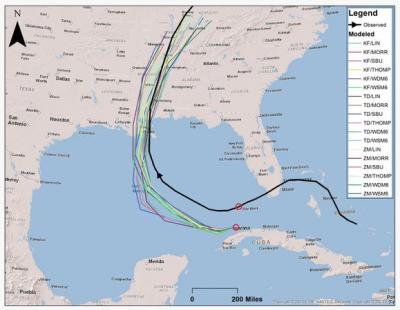Can Dynamical Downscaling Improve Tropical Cyclone Storm Surge Simulations?
Storm surge simulations are sensitive to tropical cyclone winds, so it is important to evaluate how well the latter can be simulated using dynamical models.
Reducing uncertainty in modeling tropical cyclones may advance more skillful prediction of storm surge, with important implications for our ability to evaluate the risk of coastal inundation in a warming climate.
Simulating tropical cyclone winds is challenging because they are sensitive to moist processes in the atmosphere, which are notoriously difficult to capture using models that parameterize cloud microphysical processes and convection. Department of Energy researchers at Pacific Northwest National Laboratory and collaborators evaluated the uncertainty in simulating hurricane wind and pressure as simulated by a regional model. To gain insights on modeling uncertainty, they evaluated an ensemble of regional simulations using different representations of clouds and convection for Hurricane Katrina using observed data. They used simulated winds and pressure in a storm surge model to simulate storm surge in the northern Gulf of Mexico. Then, they evaluated the storm surge simulations using high-water marks collected by the Federal Emergency Management Agency (FEMA) along the Alabama, Mississippi, and Louisiana coasts. Results showed that the regional simulations of Hurricane Katrina are sensitive to the parameterizations of both convection and cloud microphysical processes, which are linked to the development and intensification of the hurricane. With the most skillful simulation of hurricane winds and pressure from the ensemble of simulations, error statistics of the storm surge simulations were comparable to storm surge simulations driven by observed winds and pressure. This finding demonstrates the feasibility of simulating storm surge and inundation using regional simulations of hurricane winds and pressure, and a storm surge model to analyze climate change effects on coastal inundation.


